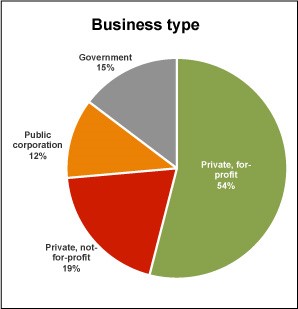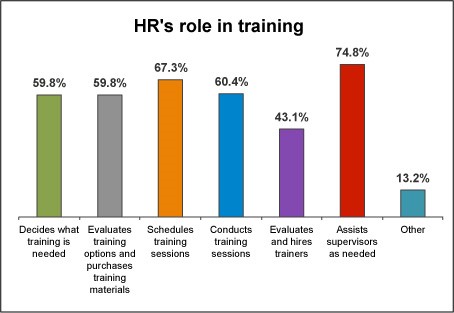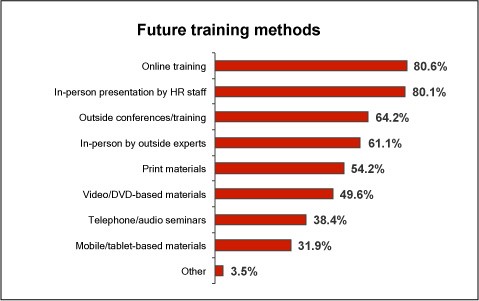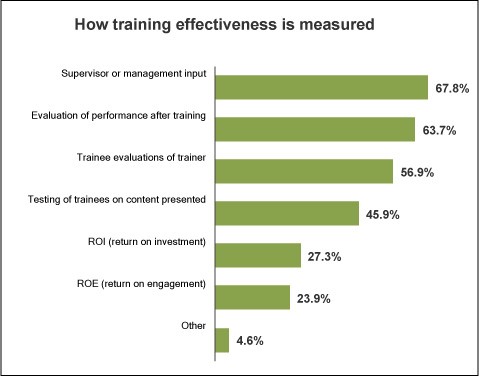Professional development is one of the greatest keys to retaining talent—so it’s important to be in the know for best practices! Read on to see how our survey participants are dealing with training and development.
 |
Highlights of the 2015 Training and Development Survey:
- HR management is involved in training decisions for 63.8% of respondents—slightly edging out executive management (which is involved in training decisions for 63.6% of the response pool).
- The most popular method of training for the future is online training, with 80.6% of participants indicating they expect to use this method in the coming years.
- For 15.8% of respondents, the number one complaint regarding training is a limited budget.
- BLR® is a recommended source/vendor for training for 51.7% of respondents.
Thank you to all 976 individuals who participated in the survey! Here are the detailed results.
Participants
Organizations with up to 250 employees account for 53.5% of our survey participants and 23.1% have 251 to 1,000 employees. Another 13.7% employ 1,001 to 5,000 individuals, and 9.7% of survey respondents work in organizations with more than 5,000 employees.
Privately owned, for-profit organizations are represented by 54% of survey participants and not-for-profit organizations account for 19.6%. Public corporations make up 11.7%, and governments represent 14.7%. Industries include:
- Manufacturing—15.3%
- Health care and social assistance—14.3%
- Finance and insurance—8.6%
- Educational services—10.4%
- Public administration—5.7%
- Professional, technical, and scientific services—6.4%
- Retail trade—2.9%
- Transportation and warehousing—4.5%
- Other services (except public administration)—11.2%

Our 976 survey participants are classified as staff (16.6%), supervisor (7%), manager (55.8%), and VP or higher (20.6%).
HR’s Role
HR not only decides what training is needed (59.8%) but also evaluates training options and purchases training materials (59.8%). HR schedules training sessions (67.3%) and conducts the training (60.4%) as well. Additionally, HR helps supervisors with training for employees as needed (74.8%) and evaluates/hires trainers (43.1%).

When asked who makes decisions about training, 63.6% (85.2% in 2014 and 70% in 2013) of the participants in our survey indicated that it’s executive management. Human resources management is involved in making those decisions for 63.8%. In-house counsel is involved in the decision-making process for 7.3% and training/development staff is involved for 35% of survey participants. Supervisors and managers, however, are involved in the decision-making process for 57.3%.
Once you have top talent, be sure to retain them! It’s all in the new HR Playbook, Employee Retention and Satisfaction: How to Attract, Retain, and Engage the Best Talent at Your Organization. Find out more or order here!
Training Process
Full-time trainers are on staff for 36.6% (up from 29.5% in 2014), while 39.3% utilize a learning management system. One hour is the typical session length for employee training for 35.3% of survey participants, and it is 2 hours for 18.7%. For 17.6%, 4 hours is the norm and a half-hour is the session of choice for 13.2%. Ninety minutes is regularly scheduled by 11.2%, and all day training is typical for 22.5%. Forty-five minutes is the usual for 11.3%, and training sessions of 15 minutes or less trails the pack at 5.3%.
Our survey shows that the method used most regularly for training employees is in-person presentations by HR at 56.1%, followed by providing printed materials at 37.7%. Online training is used regularly by 24.9%, and video-based or DVD-based materials are regularly used by 16.1%. In-person training sessions presented by experts from outside the company are a regularly used method for 20.6%. Outside conferences are a regular staple for 15.8%, and 11.7% regularly utilize telephone/audio seminars.
In the coming years, 80.6% expect to use online training, and 80.1% plan to utilize in-person sessions conducted by the HR staff. Video/DVD will be used by 49.6%, and mobile/tablet-based materials will be used by 31.9%. Telephone/audio conferences will be utilized by 38.4%. Experts from outside the organization will be brought in by 61.1%, and attendance at outside conferences will be a staple for 64.2%.

Recruiting strategies? Onboarding practices? What’s working in retention? It’s all in this report: Recruiting Best Practices: Finding and Attracting Talent in 2015’s Challenging Business Climate. Click Here
Budgets
Compliance training budgets in 2016 will remain level with 2015 for 54.7% and will increase for 22.2% of survey participants who answered this question. Development training leads the budget increase list at 35.3% followed by technical/professional training at 27.5%. Dollars budgeted for training infrastructure (e.g., LMS) will bump up for 12.3%, and training budgets for HR staff (train the trainer) will increase for 19%.
Metrics
Measuring the effectiveness of training is a formal process for an average of 47.6% (up from 24.4% in 2014) who answered this question in our survey. Supervisor or management input leads the list at 67.8% (26.8% in 2014), followed closely by evaluation of employee performance at 63.7%. Trainee evaluation of the trainer comes in next at 56.9% (43.2% in 2014), then testing trainees on the training content at 45.9% (33.8% in 2014). ROI (return on investment) and ROE (return on engagement) round out the list at 27.3% and 23.9%, respectively (up from 9.1% each in 2014).

In tomorrow’s Advisor, we’ll cover more results of the 2015 Training and Development Survey, plus an introduction to the new HR Playbook, Employee Retention and Satisfaction: How to Attract, Retain, and Engage the Best Talent at Your Organization.
